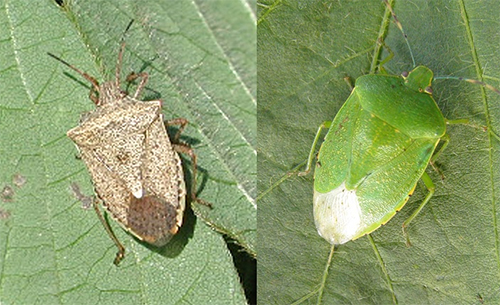Bean leaf beetle (BLB): There was a surprising number of overwintering BLB adults this spring, which mate and lead to the first generation adults that enter pod stages of beans this time of year. This pest is only a concern for IP, food grade and seed soybeans as well as dry beans. Leaf feeding is not really the issue at this point; it is the pod feeding that can introduce pod diseases and impact seed quality (Figure 1). For IP, Food Grade or Seed Soybeans, if 10% of the pods on the plants have feed scars on them during the R4 to early R6 stages, a spray is warranted. For Dry Beans, with higher value and stringent quality standards, if 5%–8% of the pods inspected have feeding scars, control may be necessary. If pods are being clipped and found on the ground throughout the field in either crop, an application is also warranted. Ensure that adults are still presently active in the field before spraying and consider days to harvest intervals when selecting which products to use.
Stink bugs and tarnished plant bugs: The easiest to spot “bugs” found right now have been stink bugs (Figure 2) and tarnished plant bugs. Both adults and nymphs feed directly on pods and seeds of soybeans and dry beans, using their piercing and sucking mouthparts. As they pierce the pods, they inject digestive enzymes into the seeds, causing the seed to dimple or shrivel, resulting in picks. The feeding wound provides an avenue for diseases to gain entry into the pod and seed quality is reduced. Indirect effects of stink bug feeding can include delayed maturity — green bean syndrome —of injured plants, though stink bugs are not the only cause for green bean syndrome. For these two pests, a sweep net is the best tool to assess populations as they are fast moving. Take 20 sweep samples (in a 180° arc sweep) in five areas of the field and determine the average number of adults and nymphs per sweep by dividing the total count by 100. In IP, Food Grade or Seed Soybeans and Dry Beans, control is warranted if an average of 0.2 stink bugs per sweep is found (or 20 bugs in 100 sweeps) in R4 to early R6 stage beans. Even in crush beans, control may be warranted if an average of 0.4 stink bug adults or nymphs per sweep is found during these stages.

Figure 2. Brown and green stink bug adults, respectively. T. Baute, OMAFRA
Tarnished plant bugs tend to prefer dry beans and warrant control if an average of one to two tarnished plant bugs (nymphs or adults) per sweep is found during the pod stages.
Source : fieldcropnews